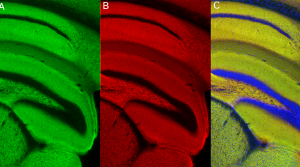sdAb anti-ALFA
275,00 € – 625,00 €
In-house developed single-domain antibody (sdAb) that recognizes a small rationally-designed epitope tag ALFA.
The ALFA-tag is a novel, rationally designed epitope tag (SRLEEELRRRLTE) and is part of the proprietary technology of NanoTag. In contrast to most conventional epitope tags, the ALFA-tag was developed based on rational considerations, which enabled us to equip it with desired features (learn more about the ALFA system here). The ALFA-tag, in combination with three sdAbs, offers a unique platform to employ a single epitope tag in virtually all biochemical and biomedical applications. A full characterization of the system can be found in an open source article published in Nat. Commun. in 2019.
| Variations: |
|
||||||||||||||||||||
|---|---|---|---|---|---|---|---|---|---|---|---|---|---|---|---|---|---|---|---|---|---|
| Related Products: |
FluoTag®-X2 anti-ALFA (Cat. No. N1502) sdAb anti-ALFA Halo fusion (Cat. No. 1541) Recombinant anti-ALFA antibody (rHcAb) (Cat. No. N1582 – N1586) anti-ALFA Bispecifics (Cat. No. N1590 – N1592) View related products |
||||||||||||||||||||
| Clone: | 1G5 | ||||||||||||||||||||
| Host: | Alpaca | ||||||||||||||||||||
| Produced in: | E.coli | ||||||||||||||||||||
| Application: | IF, WB | ||||||||||||||||||||
| Dilution: | ELISA with sdAb anti-ALFA HRP 1:5000 | ||||||||||||||||||||
| Capacity: | N/A | ||||||||||||||||||||
| Antigen: | - | ||||||||||||||||||||
| Targets: | ALFA-tag | ||||||||||||||||||||
| Specificity: | Recognizes the ALFA-tag (SRLEEELRRRLTE). | ||||||||||||||||||||
| Formulation: |
DBCO- and Biotin-conjugated sdAbs (1:1 labeling on the C-terminus) are lyophilized from PBS pH 7.4. Unconjugated sdAbs are lyophilized from 5 mM KPi pH 6.0, 300 mM NaCl, 0.5 mM EDTA pH 6.0. Reconstitute with 250 µL pure deionized water for immediate use or with 250 µL sterile 50% glycerol for storage at -80°C. The HRP-conjugated sdAbs are lyophilized from HRP protector buffer and should be reconstituted with 200 µL pure deionized water for storage at 4°C or with 200 µL high purity, sterile 50% glycerol for storage at -80°C. For more details, click the Protocols button above and check Reconstitution and Storage. |
||||||||||||||||||||
| kDa: | 16.0 | ||||||||||||||||||||
| Ext Coef: | 18638 | ||||||||||||||||||||
| Shipping: | Ambient temperature | ||||||||||||||||||||
| Storage: |
Vials containing lyophilized reagent can be stored at 2-8°C for up to 12 months. After reconstitution, store at -80°C for up to 6 months. Working aliquots can be stored at -20°C for up to 4 weeks. For more details, click the Protocols button above and check Reconstitution and Storage. |
||||||||||||||||||||
| Protocols: |
Relevant protocols can be found under the Protocols button above. For additional information, visit our Resources page. |
||||||||||||||||||||
| References: |
|
||||||||||||||||||||
| Notice: | To be used in vitro/ for research only. Non-toxic, non-hazardous, non-infectious. | ||||||||||||||||||||
| Legal terms: | By purchasing this product you agree to our general terms and conditions. |






